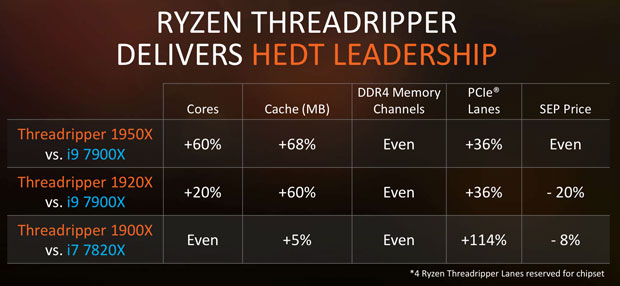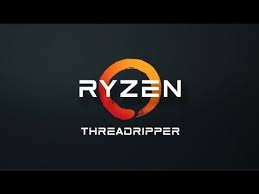AMD HEDT Chip: Threadripper makes a huge splash!

AMD HEDT Chip: Threadripper makes a huge splash!
Written by John Ham Published Wednesday, August 30, 2017 - 13:56On August 10th, AMD launched its HEDT (High End Desktop) and workstation processor named Threadripper. So, what’s the big deal you ask? Well, let me tell you! AMD has been absent (mostly) from the HEDT and workstation space which racks up a large quantity of orders by companies around the world. It’s not that AMD didn’t want to be in this space, rather they didn’t have a process that was able to compete with Intel’s offering on speed and capabilities. So what does this mean? It means we have more competition driving better products with better performance at a better price. Get the hint? Better, Better, Better and oh yeah, BETTER!
| Threadripper 1950X | Threadripper 1920X | Threadripper 1900X | |
|---|---|---|---|
| Cores | 16 | 12 | 8 |
| Threads | 32 | 24 | 16 |
| Frequency (GHz) | 3.4 | 3.5 | 3.8 |
| Boost (GHz) | 4.0 | 4.0 | 4.0 |
| XFR Boost (MHz) | 200 | 200 | 200 |
| PCIe Lanes | 64 | 64 | 64 |
| Memory Channels | 4 | 4 | 4 |
| Price | $999 USD | $799 USD | $549 |
With the information post Threadripper announcement, we got new products from both AMD and Intel to compete in this space with and overall increase in cores/threads and features. For nothing but offering competition in a new market, we the consumers just won serious benefits! That is the power that competition brings and I’m happy to finally see AMD bringing some innovation and quality in the high end desktop and workstation market.
Now, let’s get down to the details on these beastly little chips and see what makes them innovative and worthy of competition with Intel.

Threadripper is the first to offer an increase in the desktop space that has never been seen before, 16 cores with 32 threads. The 16 core Threadripper will sit at the top while lower models offer 12 and 8 cores. AMD went a step further and implemented SMT (Simultaneous Multithreading) which provides the ability to run 2 threads per core and increases efficiency for workload tasks. Because of SMT, we will now see similar process scaling and representation that Intel had with HT (Hyper-Threading). These two technologies are different in implementation and maturity but the basis for the technology has been in the server industry for a very long time. SMT is not something newly created by AMD but is finally being leveraged and well implemented by the looks of early benchmarks.
Beyond the cores and threads, what else does it have to offer? Well, it significantly ups the memory support with a max of 1TB of DDR4 memory at 2666 speeds in a quad channel configuration. Not only can it support 1TB but it also has different memory settings (Gaming or Compute) to enhance the power user experience. The memory can be configured to increase performance in a gaming or computer driven workload through the Ryzen Master application. The new chipset and CPU will also support up to 64 PCIe lanes which enables multiple devices (GPU or NVMe) to be connected at full PCIe speeds without sharing lane bandwidth. Keep in mind that 4 lanes are reserved for chipset communication leaving 60 available for device connectivity.

Given all these improvements and features, how does it fair against Intel’s newest i9 lineup? Fairly well actually, but it will depend on the workload you want and general use activities you plan on doing. In general, the Threadripper series will offer competitive performance but it doesn’t win every category or every test. Generally speaking, the Intel i9 and Threadripper trade blows and offer similar compute and gaming performance. Intel does offer an i9-7980XE processor that should win in most categories due to clock frequencies, but will cost you a massive $1999 compared to Threadrippers top chip 1950X at $999.

An additional note worth mentioning, each Threadripper model (1950X, 1920X, 1900X) has the ending letter of “X”. This signifies that it supports the new feature XFR, which was first introduced with the Ryzen series desktop processors. This means each model has an extended boost range given thermal and power availability. This is done through intelligent sensors built into the chips themselves and provides a “bare metal” reading to squeeze out a little extra performance at no additional cost or time to the user.
Finally, to conclude all this, the power and thermal expectations for Threadripper are impressive. AMD choose to use solder between the heat spreader and chips, while Intel has chosen a paste solution as it has done for the past few generations. I personally am not a fan of the TIM implementation by Intel and have had multiple bad experiences with heat and overclocking because of it. That being said, Threadripper is listed to have a max of 180W TDP while the i9 has a listed 140W TDP. In all honesty, the Intel i9 is known to jump over 200W and has issues with cooling based on the heat spreader and TIM usage. Threadripper is too new to provide real numbers but we will certainly update this article once we have finalized numbers on power and thermals.


